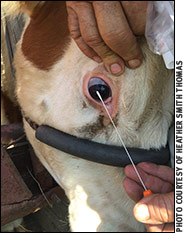Custom-made Pinkeye Control
Autogenous vaccines are working in the field, even with direct exposure.
Herd health management for disease prevention is crucial today, and vaccination is an important aspect of most herd health programs. However, if a producer is using a vaccine that does not provide adequate protection or does not include an antigen for the specific pathogen causing disease, another option is to develop an autogenous vaccine. A sample containing the pathogen(s) can be sent to a laboratory for isolation and identification of pathogens and vaccine production for that herd.

Obtained by swabbing the eye, a sample containing the pathogen(s) causing the problem can be sent to a laboratory for isolation and identification of pathogens and vaccine production for a herd.
Paul Cotterill, Cherryvale Veterinary Clinic, Cherryvale, Kan., has used various autogenous vaccines for about 15 years.
“The pinkeye vaccines seem to work,” he says. “We have now given over 100,000 doses of autogenous pinkeye vaccine. This gives a pretty good idea about efficacy.”
Cotterill says herds vaccinated with the autogenous vaccine have remained healthy even though cattle next door, separated by a wire fence, had horrible cases of pinkeye. The custom vaccines held in light of facial contact across the fence and flies going back and forth.
“In one situation, there wasn’t a single bad eye in the cattle that were vaccinated,” he says.
In challenges where one herd was vaccinated with a commercial vaccine and cattle on the other side of the fence were given the autogenous vaccine, those given the autogenous vaccine had minimal to zero cases of pinkeye, he shares.
Many of the samples his team has submitted to MVP Laboratories (now Phibro Animal Health) have contained multiple strains of Moraxella bovoculi instead of just M. bovis. They’ve also cultured Mycoplasma, Cotterill says. “These are not in the commercial vaccine.”
He’s found some shared isolates with another practitioner in Missouri. “Some cattle taken to the sale barn where he works come over here,” Cotterill says. "Putting isolates from both places in the autogenous vaccine has improved efficacy for both parties."
“Cattle are moved around a lot, so we are seeing more strains of bacteria that cause pinkeye,” Cotterill says. “As we get an outbreak or a new case crops up, we take a swab. The company cultures those samples to see what we have, and genetically tests them to see what the variance is, using a dendrogram. They run those dendrograms to find out what degree of differences there are. Once it reaches a high enough variance from the ones we have in our vaccines, they call it a non-like strain and add it to the vaccine.”
The process provides a continual way to update the vaccine, he explains.
“Some of the strains are so close, we figure there will be a bit of cross-protection, since you can only get so many different isolates in a vaccine. We have nine or 10 different isolates in the vaccine we are currently using,” he says.
“In our area — 40 miles either direction — there are owners who share pastures or have fenceline contact with other herds on the pastures they rent. Cattle that have been hauled to pasture 20 miles or so either direction become exposed to cattle that were hauled 20 miles from a different direction. There is exposure over a large area,” he says. “This is why we get good benefit from our autogenous vaccine, even for our clients with herds that are not right next door to each other.”
The regulations for autogenous vaccines require filling out forms for adjacent or non-adjacent herds.
“We try to keep those forms as current as we can, so the state veterinarian can keep up on where we are using the vaccines,” he says.

Editor’s Note: Heather Smith Thomas is a freelance writer and cattlewoman from Salmon, Idaho.






